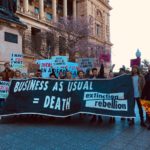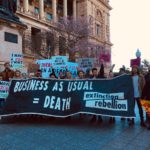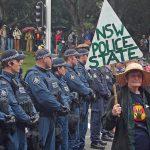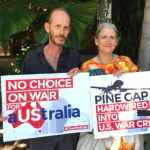Occupy Sydney on the Extinction Rebellion: The Lessons Learnt
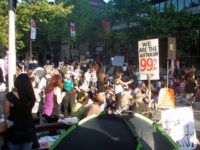
Tuesday saw Extinction Rebellion (XR) protesters taking to the Brisbane streets with the aim of causing peaceful disruption to bring about societal change, so that a global climate catastrophe can be averted. And over 70 rebels were arrested, as they put themselves on the line for the cause.
Meanwhile, south of the border, climate actions are on the rise. The NSW XR movement is currently going through a process of scaling-up and decentralising. And this Friday evening activists will be taking to the Sydney CBD streets to halt traffic for climate justice.
Emerging out of London in the last days of the current decade, Extinction Rebellion is a response to the much documented – yet much denied – climate emergency. It tips its hat to other grassroots movements, including Occupy: the social change mobilisation that surfaced early on this decade.
Occupy initially hit in September 2011, when thousands gathered in New York’s Zuccotti Park to stand against the global injustice wielded by corporations and the financial sector. And it’s ethos resonated so widely that Occupy Sydney appeared in Martin Place in mid-October that year.
Initiated by the un/official Martin Place mayor Lanz Priestley and Extinction Rebellion Bondi Beach organiser Larissa Payne, Occupy Sydney was the longest ongoing occupation on the globe. So, we decided to pick the brains of the initial promoters of the movement about activating societal change from the ground up.
Exposing the corporatocracy
“The most profound impact Occupy had was the change in political discourse,” Ms Payne related. “Things like the concept of the 99 percent and the 1 percent.” And the recognition that “government legislates in favour of industry and corporations, rather than people”.
“In terms of Australia, we were calling for an inquiry into the banking sector,” the activist told Sydney Criminal Lawyers. “While we didn’t twist Malcolm Turnbull’s arm”, the former PM did go on to establish the Royal Commission into banking misconduct in late 2017.
Extinction Rebellion is a movement in its own right, according to Payne. But, there are links. Co-founder of XR Roger Hallam played a part in the Occupy movement in the UK. So, he brings his earlier grassroots activism knowhow to the emerging mobilisation.
And take one of those old political cartoons of an “apocalyptic octopus”, Ms Payne suggested. One of its tentacles would be the banking sector, which Occupy was focused on, while XR is targeting another tentacle being the environment. But, both movements are fighting the same creature.
For the first three months, Occupy Sydney focused on protesting the corporate take over of government, but then it underwent a shift, Ms Payne recalled. “Lanz changed the focus to the homeless safe space and kitchen.”
A continuing mobilisation
“Its lasting impact has been the widespread recognition that a lot of the structures that we used to take as trusted entities can’t be trusted anymore,” Mr Priestley made clear. “Significantly, the banks and the wider financial establishment.”
“In Martin Place, we lasted just over three years,” he went on. And over that time, the protest movement morphed into Sydney’s first 24/7 homeless service, as Priestley already had over a decade and a half of working with those experiencing homelessness under his belt.
Indeed, 2017’s Martin Place Tent City – which brought the issue of homelessness to the fore – was a direct descendant of Occupy. And the street kitchen and safe space revealed the ugly side of the Berejiklian government, as it passed laws specifically to run rough sleepers out of the public mall.
To Priestley, both the Occupy movement and the Rebellion are a continuum of a social trajectory that emerged long before either movement. And he believes that the essence of XR will make its impact and then disband, before rising again in another form.
“One of the lasting legacies of Occupy,” Priestley emphasised, “and one of its intentions, was to bring people with a broad range of common interests within one space and act as an introduction agency.” And this broad global network of activists is still connected to this day.
A leaderless movement
Both Occupy veterans point to the decentralised structure of XR as linking back to Occupy. However, Payne says that while the “structureless” organisational model of the earlier movement was great, she sees XR’s decentralised model – with autonomous branches linking together – as more refined.
“We don’t want to replicate the pyramid hierarchical structure of the status quo. And that’s a challenge, because it’s just a part of what we know,” Ms Payne explained. “It’s what we have been born into, so not to replicate it is difficult.”
Extinction Rebellion NSW was initiated by climate activist Caz Chattin. And now that umbrella group is beginning to decentralise into local chapters, with a branch in Bondi, one in the Inner West and another across the bridge in Northern Sydney.
Consensus decision-making
In Priestley’s opinion, one of the lessons learnt by Occupy that the Extinction Rebellion could heed is about consensus decision-making. This is the process of having all parties coming to the same opinion on any given decision, which was a key aspect of the Occupy movement.
“Consensus is a decision-making process that works in its pure form, when you’ve got unlimited time to make a decision,” Mr Priestley outlined. “But, when you’ve got the riot squad 200 metres away, you don’t have time for consensus decisions.”
“The idea is to understand when consensus decision-making should be used,” he elaborated, “and when other forms of decision-making should come into play.”
The hourglass is running down
Ms Payne said the obvious divergence between the movements is that XR is dealing with the “life and death situation” that humanity is now facing, as the world is going through its sixth mass extinction and time is running out.
The Intergovernmental Panel on Climate Change warned last October that governments have 12 years to halt the greenhouse gas chugging economy to prevent a climate catastrophe. And the latest reports state that the political framework to bring this about must be in place by the end of 2020.
“We don’t have time to muck around,” Ms Payne concluded. The compounding changes to the climate – resulting in rising tides, harsher weather patterns and sporadic wildfires – are going to affect greater numbers of “everyday people on the ground within the next couple of years.”


